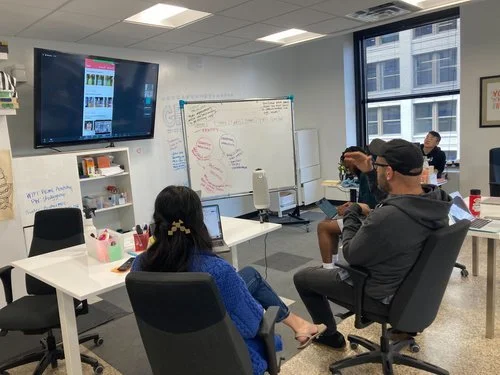Chuuzer
Client: Chuuzer
Roles: UX Writer, UX Researcher, UX Designer
Methods: Usability Testing, Remote Participant Observations, Architectural Diagramming, Prototyping, Annotated Documentation, Cognitive Walkthrough, Primary User Research
Tools: Figma, Zoom, Google Docs, Otter.ai
Team: Michael Roth, Liz Torres, Jenn Vang, Connor Squires, Oladipo Aluko
The Brief:
Revise the existing design of an app that aims to use polls to communicate with friends and family as they work to make choices
What I Did:
I researched and designed revisions to the app. This included a cognitive walkthrough, primary user interviews, information architecture, wireframing, and prototyping
Introduction
Chuuzer is an app whose aim is to have its users create polls and respond to them quickly. Users can create polls private to their friends and family, who can respond quickly with data for them to make decisions.
Chuuzer was in beta testing for iOS and they were exploring more options and improvements to the app before going live with their product.
Chuuzer wanted me to look at their app to see ways in which it could be revised for better usability.
The Process
Cognitive Walkthrough
Primary User Research
Research Synthesis
Write User Stories
Create Prototype Plan
Build and Annotate Prototype
This process allowed for me to create a prototype with as much information as possible from current users, as well as determine what was other potential pain points might exist based on my own walkthrough. My redesign was aimed to remedy those discoveries as well as the pain points of the current user base.
The Research
How do current users of the Chuuzer app find their way around?
Where is there room for improvement? How can I re-design something that functions more smoothly for the user?
For this project, I did a cognitive walkthrough to assess the different steps of taking on the two major tasks of Chuuzer users: creating polls and responding to polls.
As I did the cognitive walkthrough, I took screenshots of each task in the process, making sure that the user had the proper mental model, visibility, hierarchy, mapping, consistency, and feedback, while offering suggestions or rationale as to how to fix the problem.
Afterwards, based on the walkthrough, we created a script to do some primary user research. My team and I observed two users, one new to the app, and one established user and engaged in a think aloud protocol with both users as they worked through Chuuzer’s different functionalities, expressing their pain points and exciters.
From the cognitive walkthrough and primary user research, we found that users had several pain points and desires for the Chuuzer app, including:
management of old polls
curation of groups through adding and deleting group members
sending photos to Chuuzer directly through the camera app
more “poll-like” functionality including the ability to share a poll creator’s final decisions
the ability to block and flag objectionable users
With this in mind, I wrote these user stories to help drive my design process:
User Story #1 : As a frequent user, I want to curate and modify my old polls so that I can declutter my Chuuzer polls and gain efficiency, control, and clarity.
User Story #2 : As a frequent user, I want to make my polls reflect what real polls are like- select an option and gain feedback on what option is selected the most frequently, so that I can receive quick feedback from groups when making decisions.
User Story #3: As a frequent user, I want to be able to edit my groups, so that I can have better curation over the Chuuzer app and gain more control and clarity over my data within the app.
Cognitive Walkthrough
Primary User Research
User Stories
The Design Iterations
Initially, I redesigned the Information Architecture of the Chuuzer app in order to include my proposed changes to the app. My aim was to create features that would allow users to delete and edit old polls, to give more options for poll responders, so a user’s mental model of polling would be reflected in the app, and more ability to edit and modify groups for greater flexibility.
Next, I created some lo-fi prototypes to solidify some of my ideas for how screens might look during some of the proposed changes to the Chuuzer app.
Using the lo-fi prototypes, I created a hi-fidelity prototype to demonstrate how these new flows would work within the app.
Check out my video walthrough of the Chuuzer app!
Information Architecture
Lo-Fi Prototyping
Hi-Fidelity Prototyping
Next Steps
What was improved?
My designs met users’ needs by adhering more closely to their mental model of what polls truly are. Additionally, the new functionality allows for better maintenance of the app and less clutter.
Testing
My next steps with Chuuzer would be to test these design iterations with their current users. I would repeat this process and revise the functionality of the app as necessary.











